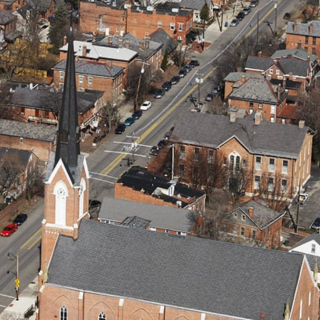Hundreds of Columbus residents who have been living in tents and other makeshift shelters – community members who cannot afford traditional housing – have been evicted by the City of Columbus. More evictions of tent camps utilizing bulldozers are in the works, including the encampment at Heer Park scheduled for this Tuesday morning where anywhere from 60 to 100 community members reside.
A City eviction notice ducted-taped near the park states “you will be arrested if you are still there on June 14th” when City workers “come in for remediation,” which means all items will be removed and likely with the apparent efficiency a bulldozer provides. This type of so-called bulldozer “remediation” occurred near Green Lawn Cemetery roughly two weeks ago.
Heer Park, which is adjacent to the Great Southern shopping center, was closed by the City during the winter of 2021, but then become a temporary or state-of-flux community for those who, as some describe it, are “camping out.” But the reality is, pitching a tent and sleeping outside is the end-of-the-line when someone is facing the multiple stages of houselessness.
“We refer to those we serve as houseless or unhoused, not homeless,” said Emily Myers, the 30-something founder of local mutual aid group Heer To Serve, which has served those living at Heer Park and surrounding encampments since 2020. “We say this because the tents, vehicles and other makeshift dwellings in which they reside are their homes. These camps they have been living in are their communities. The City of Columbus has torn these communities apart to sweep the problem under the rug, and to enable development and construction.”
Myers began her advocacy in 2020 by setting up shop in the Heer Park parking lot “out of the trunk of her car,” offering clothing, shoes, blankets, food, harm reduction information, Naloxone, etc. Her advocacy has evolved into multiple tables and a canopy.
“Basically we’ve been loving on this community for two years, getting to know people,” she said. “Our friends on the south side have been living on land that will soon be home to a variety of developments, including a new bike trail head and a canoe livery and bar. The City of Columbus has been sending the Columbus Police to harass them and force them out of their encampment.”
Camps all over Columbus of late have been swept by Columbus police, says Myers and other local houseless advocates. But there is nowhere for these people to go due to a lack of available beds in Columbus shelters and a lack of affordable housing.
When a camp sweep occurs, residents are warned typically a couple of weeks in advance they need to leave.
Those remaining in their tents the day of the camp sweep are arrested for trespassing. The City does not provide any help to those who need to relocate and has no recommendations as to where they should go.
“The City still owns it (Heer Park),” says Myers. “I’m sure they will [develop it], but they won’t tell anybody anything. They’re saying they don’t have any plans right now. But yet they’re putting people out June 14th and threatening bulldozers. It sounds like a plan to me.”
Many believe Columbus is staring an affordable housing crisis in the face, or that Columbus is already in the eye of the storm – like Austin, Texas or San Francisco.
“We’re definitely in the midst of it. We’ve been in the midst of it for many years. We are 54,000 units short just for affordable housing, and that’s just to keep with demand that’s already here,” says Myers.
The Community Shelter Board and local HUD workers make a “Point-in-Time-Count” once a year, during the winter. A Point-in-Time Count is a count of sheltered and unsheltered people who are experiencing houselessness.
Myers says this year’s Point-in-Time-Count for Columbus resulted in “3,000 to 4,000” houseless, but she and others believe this total is not accurate and doesn’t fully expose the reality.
“That doesn’t count everybody, by a long shot. Because when they do the land count and if they don’t find you in your tent, they don’t count you. And they don’t count people who are living in cars, and they don’t count people who are doubled-up with other people,” said Myers.
She believes the truer number of those experiencing houselessness in Columbus is closer to a minimum of “25,000.”
“There’s different types of houselessness, it’s not just people living in tents. It’s people who are in living in their cars. The third group are the people living in shelters. And the fourth group, is the hidden one, that’s what they call it, the ‘hidden homeless.’ or people are doubled-up with other people,” said Myers.



